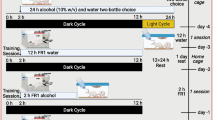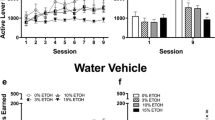Abstract
Rationale
Alcohol consumption shows circadian rhythmicity, i.e., alcohol preference and intake change with circadian time. Circadian rhythmicity is controlled by a biological clock, which has been shown to govern behavioral, physiological, and hormonal processes in synchronization with internal as well as external cues. Molecular components of the clock include circadian clock genes such as period (Per) 1, 2, and 3. Previously, our lab demonstrated the involvement of mouse Per1 (mPer1) and Per2 (mPer2) in modulating cocaine sensitization and reward. What is more, we investigated voluntary alcohol consumption in Per2 Brdm1 mice with the results suggesting a relationship between this circadian clock gene and ethanol consumption. Objective To further complement the mPer2 study, our lab proceeded to assess mPer1’s possible role on alcohol intake using operant and free choice two bottle paradigms.
Methods
Using operant conditions, Per1 Brdm1 and wild type mice were trained to self-administer ethanol (10%) under a fixed ratio 1 (FR1) paradigm. This was ensued by a progressive ratio (PR) schedule. Furthermore, extinction sessions were introduced, followed by reinstatement measures of ethanol-seeking behavior. In another set of animals, the mice were exposed to voluntary long-term alcohol consumption, ensued by a 2-month deprivation phase, after which the alcohol deprivation effect (ADE) was measured.
Results
Mutant mice did not display a significantly divergent number of reinforced lever presses (FR1 and PR) than wild type animals. Furthermore, no significant differences between groups were obtained regarding reinstatement of ethanol-seeking behavior. Similar results were obtained in the two bottle free choice paradigm. Specifically, no genotype differences concerning consumption and preference were observed over a broad range of different ethanol concentrations. Moreover, after the deprivation phase, both groups exhibited significant ADEs, yet no genotype differences.
Conclusions
Contrary to the mPer2 data, the present findings do not suggest a relationship between the circadian clock gene mPer1 and ethanol reinforcement, seeking, and relapse behavior.






Similar content being viewed by others
References
Abarca C, Albrecht U, Spanagel R (2002) Cocaine sensitization and reward are under the influence of circadian genes and rhythm. Proc Natl Acad Sci U S A 99(13):9026–9030
Albrecht U (2002) Invited review: regulation of mammalian circadian clock genes. J Appl Physiol 92(3):1348–1355
Albrecht U, Eichele G (2003) The mammalian circadian clock. Curr Opin Genet Dev 13(3):271–277
Bargiello TA, Jackson FR, Young MW (1984) Restoration of circadian behavioural rhythms by gene transfer in Drosophila. Nature 312(5996):752–754
Dallmann R, Touma C, Palme R, Albrecht U, Steinlechner S (2006) Impaired daily glucocorticoid rhythm in Per1 (Brd) mice. J Comp Physiol A Neuroethol Sens Neural Behav Physiol 192(7):769–775
Danel T, Touitou Y (2004) Chronobiology of alcohol: from chronokinetics to alcohol-related alterations of the circadian system. Chronobiol Int 21(6):923–935
Freund G (1970) Alcohol consumption and its circadian distribution in mice. J Nutr 100:30–36
Gachon F, Nagoshi E, Brown SA, Ripperger J, Schibler U (2004) The mammalian circadian timing system: from gene expression to physiology. Chromosoma 113(3):103–112
Hiller-Sturmhofel S, Kulkosky P (2001) Chronobiological regulation of alcohol intake. Alcohol Res Health 25(2):141–148
Poirel C, Larouche B (1986) Murine circadian patterns of eating and drinking behaviors revisited: rhythmometric analyses and neuro-ethological comments. Chronobiologia 13:345–350
Possidente B, Birnbaum S (1979) Circadian rhythms for food and water consumption in the mouse, Mus musculus. Physiol Behav 22:657–660
Reddy P, Zehring WA, Wheeler DA, Pirrotta V, Hadfield C, Hall JC, Rosbash M (1984) Molecular analysis of the period locus in Drosophila melanogaster and identification of a transcript involved in biological rhythms. Cell 38(3):701–710
Reppert SM, Weaver DR (2002) Coordination of circadian timing in mammals. Nature 418(6901):935–941
Roberts AJ, Gold LH, Polis I, McDonald JS, Filliol D, Kieffer BL, Koob GF (2001) Increased ethanol self-administration in delta-opioid receptor knockout mice. Alcohol Clin Exp Res 25:1249–1256
Rutter J, Reick M, McKnight SL (2002) Metabolism and the control of circadian rhythms. Annu Rev Biochem 71:307–331
Sanchis-Segura C, Spanagel R (2006) Behavioral assessment of drug-reinforcement and addictive features in rodents: an overview. Addict Biol 11:2–38
Spanagel R, Sanchis-Segura C (2003) The use of transgenic mice to study additive behaviour. Clin Neurosci Res 3:325–331
Spanagel R, Pendyala G, Abarca C, Zghoul T, Sanchis-Segura C, Magnone MC, Lascorz J, Depner M, Holzberg D, Soyka M, Schreiber S, Matsuda F, Lathrop M, Schumann G, Albrecht U (2005) The clock gene Per2 influences the glutamatergic system and modulates alcohol consumption. Nat Med 11(1):35–42
Stephan FK, Zucker I (1972) Rat drinking rhythms: central visual pathways and endocrine factors mediating responsiveness to environmental illumination. Physiol Behav 8(2):315–326
Stewart J, de Wit H (1987) Reinstatement of drug-taking behavior as a method of assessing incentive motivational properties of drugs. Methods of assessing the reinforcing properties of abused drugs. Springer, Berlin Heidelberg New York, pp 211–227
Zheng B, Albrecht U, Kaasik K, Sage M, Lu W, Vaishnav S, Li Q, Sun ZS, Eichele G, Bradley A, Lee CC (2001) Nonredundant roles of the mPer1 and mPer2 genes in the mammalian circadian clock. Cell 105(5):683–694
Acknowledgement
This work was supported by the BMBF (FKZ 01GS0475) and DFG (SFB 636/B1 and SP383/2-1).
Author information
Authors and Affiliations
Corresponding author
Rights and permissions
About this article
Cite this article
Zghoul, T., Abarca, C., Sanchis-Segura, C. et al. Ethanol self-administration and reinstatement of ethanol-seeking behavior in Per1 Brdm1 mutant mice. Psychopharmacology 190, 13–19 (2007). https://doi.org/10.1007/s00213-006-0592-z
Received:
Accepted:
Published:
Issue Date:
DOI: https://doi.org/10.1007/s00213-006-0592-z




